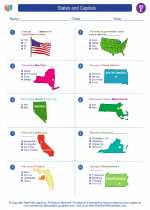States and Capitals -> landforms
Landforms
Landforms are natural features of the Earth's surface. They are created by various geological processes such as erosion, weathering, and tectonic activity. Landforms can be found on continents, in oceans, and even on the ocean floor. They come in a variety of shapes and sizes, and each one has its own unique characteristics.
Types of Landforms
There are several major types of landforms, including:
- Mountains: Large landforms that rise prominently above their surroundings, usually with steep slopes and a peak.
- Plateaus: Flat, elevated landforms with steep sides.
- Plains: Extensive flat areas with minimal height variation.
- Valleys: Low areas between hills or mountains, often containing rivers or streams.
- Deserts: Arid landforms characterized by minimal vegetation and little precipitation.
- Oceans and Seas: Vast bodies of water that cover a large portion of the Earth's surface.
- Rivers and Lakes: Bodies of water created by various geological processes, including erosion and glaciation.
Study Guide
Here are some key points to remember when studying landforms:
- What are landforms and how are they created?
- List and describe the major types of landforms.
- Explain the characteristics of each type of landform.
- Identify examples of each type of landform on a world map or globe.
- Examine the impact of landforms on human activities, such as settlement patterns and transportation.
- Understand the role of landforms in shaping the Earth's surface and influencing weather patterns.
By understanding the different types of landforms and their characteristics, you can gain a deeper appreciation for the Earth's diverse and ever-changing landscape.
[Landforms] Related Worksheets and Study Guides:
.◂Social Studies Worksheets and Study Guides Fifth Grade. States and Capitals
Study Guide States and Capitals
States and Capitals  Worksheet/Answer key
Worksheet/Answer key States and Capitals
States and Capitals  Worksheet/Answer key
Worksheet/Answer key States and Capitals
States and Capitals  Worksheet/Answer key
Worksheet/Answer key States and Capitals
States and Capitals 

 Worksheet/Answer key
Worksheet/Answer key
 Worksheet/Answer key
Worksheet/Answer key
 Worksheet/Answer key
Worksheet/Answer key

The resources above cover the following skills:
Geography: A student should be able to utilize, analyze, and explain information about the human and physical features of places and regions. A student who meets the content standard should:
Understand that a region is a distinct area defined by one or more cultural or physical features.